手机测试相关英语
英语翻译能力测试

英语翻译能力测试下面一页是测试的正文:每一小段前面是标号,每个编号有三个部分:S部分,D部分和U部分:ID:3879S部分:Incoming引入 caller-id呼叫 or SMS 短讯服务spoken aloud声讯提醒D部分:Compatible 兼容with iOS 4, 5, 6 and 7Does NOT work on iPhone 3GiCallAnnounce will announce显示 (in a human voice人工) the name of the caller呼叫 you're just receiving a call from.It can also announce显示 the full SMS details 全满的短讯详情(Sender 发送人& Text) of an incoming收到的SMS message短信服务in realtime适时地. iCallAnnounce来电提醒 doesn't stop there! Because it uses Apple苹果 inner内部的Speech 演讲Synthesizer合成器,综合者 which doesn't work for most foreign languages 外语, it can automatically自动地 translate 翻译the Caller name呼叫名 or SMS details to english so it will remain主要的 consistent 始终如一的over most languages (for eg. - Hebrew). You can change iCallAnnounce Settings by going to "Settings" -> "iCallAnnounce" on your SpringBoard跳板,出发点. The volume must be set separately 分别地,分离地,个别地, it uses the volume from your iPod music.U部分:- Bug fixes安装窃听器- Added iOS 7 support支持. - Added iPhone 5/5C/5S support. - Added "Speech Speed" for iOS 7. - Better speech analyzer分析器 on iOS 7. - Fixed some bugs.- Fixed bugs* Fixed: Silent无声 switch转换 was ignored忽视- Added Volume control 声控in Setttings - Fixed "Translate t译文:S部分:接入来电短信有声提醒D部分:能兼容iOS4,、5、6和7的操作系统的苹果3G呼叫显示即将发布通过人工服务短信提醒被呼人。
人教版七年级上册英语1单元测试题

人教版七年级上册英语1单元测试题C。
Mr。
WhiteA。
a phone numberB。
family nameD。
first name(D)4.What do you call the numbers you use to call someone on the phone?A。
a phone numberB。
family nameC。
given nameD。
first name(A)5.--- ________ is your ID number。
--- It’s xxxxxxxx9.A。
WhatB。
WhereC。
WhoD。
How四.完形填空(10):My name is Jack。
I’m 13 years old。
I’m from 1._______。
My 2._______ name is Smith。
My 3._______ name is Jack。
I’ma student。
I’m in 4._______ school。
My English teacher is Mr。
Green。
He is 5._______ teacher。
I like him very much。
I have a good friend。
His name is Tom。
He is 6._______ student。
too。
He is from America。
We are in the same 7._______。
We often play XXX 8._______ is xxxxxxxx9.You can call me 9._______ xxxxxxxx9.I have a white cat。
Its name is Mimi。
It’s very10._______.1.(China)2.family3.first4.middle5.my6.a7.class8.ID number9.at 10.cute一、英汉互译(10):1.手机号码:XXX2.她的钟表:her clock3.回答问题:XXX4.姓氏:family name5.他的姓:her family name6.一件橘色的夹克衫:an orange jacket7.很高兴见到你:nice to meet you8.你的白色your white phone9.用英语:in English 10.身份证号码:ID number二、按要求写出相应形式(10):1.what’s(缩写形式)2.I’m(缩写形式)3.her name’s(缩写形式)4.It’s(缩写形式)5.XXX’s(缩写形式)6.isn’t(缩写形式)7.Mr.(缩写形式)8.her(物主代词)9.my(物主代词)10.his(物主代词)三、单选题(15):1.B2.B3.C4.A5.A四、完形填空(10):My name is Jack。
手机测试英文作文范文
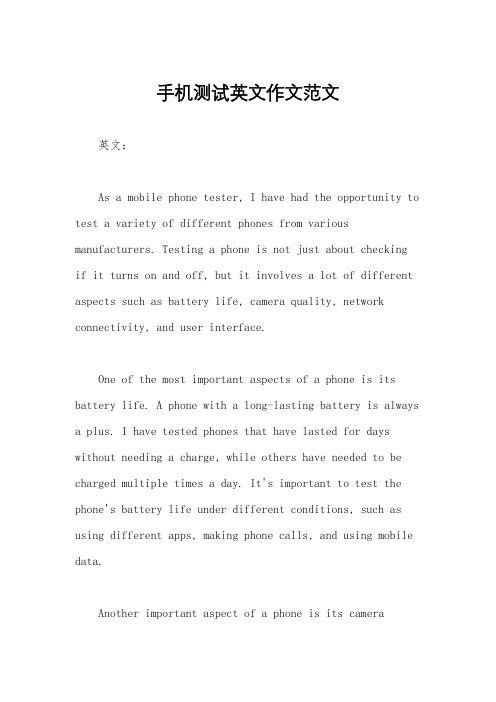
手机测试英文作文范文英文:As a mobile phone tester, I have had the opportunity to test a variety of different phones from various manufacturers. Testing a phone is not just about checkingif it turns on and off, but it involves a lot of different aspects such as battery life, camera quality, network connectivity, and user interface.One of the most important aspects of a phone is its battery life. A phone with a long-lasting battery is always a plus. I have tested phones that have lasted for days without needing a charge, while others have needed to be charged multiple times a day. It's important to test the phone's battery life under different conditions, such as using different apps, making phone calls, and using mobile data.Another important aspect of a phone is its cameraquality. Nowadays, people use their phones to take pictures more than ever before. A phone with a high-quality camera is always a plus. I have tested phones that take amazing pictures, while others produce low-quality images. It's important to test the phone's camera under different lighting conditions and to test its features such as zoom, flash, and filters.Network connectivity is also an important aspect of a phone. A phone that can't connect to the internet or has poor signal strength is frustrating. I have tested phones that connect to the internet quickly and have strong signals, while others take a long time to connect and have weak signals. It's important to test the phone's connectivity in different locations and under different network conditions.Finally, the user interface is an important aspect of a phone. A phone that is easy to use and navigate is always a plus. I have tested phones that have intuitive interfaces that are easy to navigate, while others have confusing interfaces that are difficult to use. It's important totest the phone's interface under different conditions and to test its features such as the keyboard, touch screen, and home screen layout.中文:作为一名手机测试员,我有机会测试来自不同制造商的各种不同类型的手机。
手机维修常见英语

附录一手机常见故障中英文对照1、Function Defects功能故障Power on automatically 自动开机Power off automatically 自动关机Charge trouble 不能充电No power on 不开机Stop current 掉电No wake up 待机死机Freeze up 操作死机Code poste 话机锁SIM Missing 不识卡Charge automatically 自动充电Current consumption problem 耗电大No display 无显示Display garble 显示乱Black screen 黑屏Blue screen 篮屏Segment missing 显示缺划LCD stain LtCD 黑点LCD scrach LCD 划伤Backlight problem 背景灯功能故障Not functioning keypad 按键失灵Lateral key problem 侧键失灵Key tone failure 无按键音Keypad Mechanical problem 按键异声No sound(speaker) 听筒无声Audio volume low 听筒声音轻V oice distortion 听筒杂声MIC volume low 麦克风声音轻No ring tone 无铃声Low ringing volume 铃声轻Handfree failure 无免提V oice distortion 通话杂音Camera photo illegible 拍照模糊Camera Freeze 拍照死机Camera photo problem 拍照问题Can not play image 不能播放图像Vibrator failure 振动故障Flip problem 翻盖失灵Clock problem 时钟问题2、Network Defects网络故障No network retrieval 无网络Signal weak 信号弱V oice (micro) transmit problem 不送话No sound(speaker) 通话无声Freeze while calls 通话死机Intermittent call drop 通话掉线Can not dial out 打不出电话Can not receive 打不进电话On hook error 无法挂机V oice discontinue 通话断续3、Appearance Defects显示故障Component missing 缺件6 pin bad 六针损FPC interface bad FPC 接口损Lateral key damage 侧键损Antenna broken 天线坏Antenna connector settle 天线接口问题Battery interface damage 电池接口损SIM interface appearance problemSIM卡扣烫伤Speaker connect appearance problem听筒烫伤Mainboard scratch 主板划伤Keypad scratch 按键划伤Keypad appearance 按键纸外观问题Keypad dirty 按键纸脏Bad elasticity of keyapd 按键无弹性4、S.W. DefectsSoftware ERROR 版本错BSN flag ERROR ID错附录二手机维修常见英语缩写1、移动通信网络原理常用英语AGCH(Allow)准许接入信道APN (Access Point Name) 存取点名称ARFCN(Absolutely Reverse and Forward Channel) 绝对物理信道AUC(Authentication Center) 鉴权中心BCCH(Broadcast Control Channel)广播控制信道BCH(Broadcast Channel) 广播信道BS(Base Station)基站BSC(Base Station Controller)基站控制中心BSS(Base Station Subsystem) 基站子系统BTS(Base Transceiver Station)基站收发站CBCH(Cell Broadcast Channel)小区广播信道CCCH(Common Control Channel)公共控制信道CCH(Control Channel) 控制信道CDMA(Code Division Multiple Access)码分多址接入CEPT(Conference European of Post and Telecommunications) 欧洲电信管理部门DCCH(Dedicated Control Channel)专用控制信道DCS(Digital Communications System)数字通信系统EIR(Equipment Identity Register )设备标志寄存器FACCH(Fast Associated Control Channel)快速辅助控制信道FCCH(Frequency Connection Channel)快速接入信道FDMA(Frequency Division Multiple Access)频分多址接入GPRS(General Packets Radio Service)通用分组无线业务HLR(Hold Location Register)原地位置寄存器ISDN(Integrated Services Digital Network)综合业务数字网MS(Mobile Station) 移动台MSC(Mobile Service Switching Center)移动交换中心NSS(Network Station Subsystem)网络子系统OMC(Operation and Maintenance Center)操作维护中心PCH(Paging Channel) 寻呼信道PCS(Personal Communications System)个人通信系统PDA(Personal Digital Assistant)个人数字助理PLMN(Public Land Mobile Network)公用陆地移动通信网PSTN(Public Switched Telephone Network)公用电话交换网RACH(Random Access Channel)随机接入信道SACCH(Slow Associated Control Channel)慢速辅助控制信道SCH(Synchrocyclotron Channel)同步信道SDCCH(Standalone Dedicated Control Channel) 独立专用控制信道TACS(Total Access Communication System)全球接入通信系统TCH(Trade Channel) 业务信道TDMA(Time Division Multiple Access )时分多址接入VLR(Visit Location Register )访问位置寄存器WAP(Wireless Applications Protocol)无线应用协议2、手机菜单常用英语Accessory 附加功能Adjust Contrast 对比度调节Alarm Clock 闹钟Alert Test 警告铃测试Audio Test 音频测试Bookmark 书签(Cell) Broadcasting (小区)广播(WAP)Browser 浏览器Calculator 计算器Call Log 呼叫记录Call Services 呼叫服务Camera 照相机Clear Call History 删除呼叫记录Controls /Setting 手机设置Directory/Phone Book 电话本Engineer Mode 工程模式Games 游戏Groups 群组Hands Free 免提Internet 互连网Keypad Test 按键测试Language Select 语言选择Lunar Calendar 农历MMS(Multimedia Messaging Service)多媒体短信业务Multimedia 多媒体Phone Lock 话机锁Ring/Ringing and Beeps 振铃蜂鸣Security 保密设置Set Call History 设置呼叫记录Timer 计时器Text Messages /Messages 短消息World Time 世界时间/时区3、维修仪器常用英语AC(Alternating Current) 交流电ATT 输入衰减值BER(Bit Error Rate) 比特误码率Center Frequency 中心频率DC(Directing Current) 直流电Frequency Error 频率误差Multimeter 万用表Oscillograph 示波器Peak Phase Error 相位峰值误差RBW (Resolution Bandwidth) 分辨率带宽Ref Level 参考电平RMS(Root Mean Square) 平均相位误差Spectrum Analyzer 频谱分析仪Span 显示宽度Sweep Time 扫描时间Universal Radio Communication Tester综合测试仪VBW (Video Bandwidth) 视频带宽4、手机电路图常用信号英语ADC (Analog to Digital Convert) 模数转换ALIMLCD LCD模块供电信号ANT(Antenna) 天线AUXIN 外接麦克风信号BACKKEY 按键背景灯BACKLIGHT 显示屏背景灯BACKLCD 显示屏背景灯BACKUP 备用电池BA TEMP 电池温度检测BA TT(Battery) 电池BB(Base Band Block) 基带BFRXN 外接耳机负极输入BFRXP 外接耳机正极输入BFTXN 外接麦克风负极输入BFTXP 外接麦克风正极输入BHE 高字节有效BLE 低字节有效BPF(Band Passed Filter) 带通滤波BSW(Band Switch) 频段选择开关Buzzer 蜂鸣器C(Capacitance) 电容CAMIO 摄像头数据输入输出信号CAMVDD 摄像头供电信号CDMMC 多媒体卡识别信号/写保护CHAR(Charger) 充电器CHARGEUR 充电电流输入CLK (Clock) 时钟CLK13MHORUS CPU13MHz系统时钟CLKVCXO 13MHz系统时钟CLKIOTA IOTA13MHz系统时钟CLKMIW LCD串行时钟信号CLKMMC 多媒体卡时钟信号CMDIRDA 红外线驱动信号CMDMMC 多媒体卡驱动信号CMDVIB(Command of Vibrator) 马达控制CPU(Central Processing Unit) 中央处理器Coupler 耦合器CS(Chip Select) 片选CSFLASH flash片选CSLCDL LCD片选信号CTS 允许发送DA(Data) 数据DAC(Digital to Analog Convert) 数模转换DAICLK 直接存取信息时钟控制信号DAIIN 直接存取信息输入信号DAIOUT 直接存取信息输出信号DAIRST 直接存取信息复位信号DETECT 检测信号DCAM 摄像头数据传输信号DMMC 多媒体卡数据信号DOMIW LCD串行数据信号Duplexer(Diplexer) 双工器DSP(Digital Signal Processing)数字信号处理DSR 数据设备准备好DTR 数据终端准备好EARN 耳机信号负极EARP 耳机信号正极EL(Electro Luminescence) 背光驱动EN(Enable) 使能EPN 听筒负极EPP 听筒正极ESD 静电释放FDPL FLASH复位信号FL(Filter) 滤波器FLASH 闪烁存储器FLIP/FLAP 翻盖FLIPOUT 翻盖检测信号GND(Ground) 地线HPN 扬声器负极HPP 扬声器正极HREFCAM 摄像头水平扫描信号HSMICIN 外接麦克风信号输入(负)HSMICIP 外接麦克风信号输入(正)HSOL 外接耳机输出信号(左声道)HSOR 外接耳机输出信号(右声道)I2CINT I2C总线中断信号输入IC(Integrated Circuit) 集成电路IF(Intermediate Frequency ) 中频IN 输入Inductance(符号L) 电感INT(Interrupt) 中断Interface 接口I/O 输入/输出I/Q 正交信号IrDA(Infrared ray Data Access)红外线数据接入ITDATA 中断检测信号输入KEEPACT 开机维持KEY 按键LCD(Liquid Crystal Display) 液晶显示器LDO(Low Drop Output) 降压稳压源输出LED(Light-Emitting Diode) 发光二极管LNA(Low Noise Amplifier) 低噪声放大器LPF(Low Passed Filter) 低通滤波器NRESPWRON 基带数字部分加电复位MAIN 主要MIC(Microphone) 麦克风MICBIAS 麦克风偏置电压MICN 麦克风负极MICP 麦克风正极MIXER 混频器MMC(Multi Media card) 多媒体卡MOTOR 马达N(Negative) 负OEL 读允许信号ONKEY 开机键信号OPLL(Offset Phase Locked Loop)锁相环补偿Oscillator 振荡器OSW(Oscillator Switch) 晶体选择开关OUI*(OUIL)开机信号OUT 输出P(Positive) 正P4V5 4.5V电压输出P5V6 5.6V电压输出PA(Power Amplifier) 功率放大器PACEN 功放使能信号PA_LEVEL 功率等级PAOUT 功率等级控制信号PCHAR 充电器插入中断和充电开机PCLKCAM摄像头数据传输控制时钟信号PD(Phase Detector) 鉴相器PFD(Phase and Frequency Detector)鉴频鉴相器PLL(Phase Locked Loop) 锁相环PLLON 锁相环使能信号POLMIC 麦克风偏置电压POWMMC 多媒体卡供电信号PUPLO2 频率合成电路使能信号PWM(Pulse Width Modulate) 脉冲宽度调制PWRON 开机信号R(Resistance) 电阻RD(read) 读使能信号RES(Reset) 复位RESETLCDL LCD复位信号RESTHORUS 复位信号RF(Radio Frequency) 射频RSLCD LCD内部寄存器选择RTC(Real Time Clock) 实时时钟RTS 请求发送RWL 写允许信号RX 接收RXD 接收数据RXIR 接收中断请求SAW(Surface Acoustic Wave) 声表面滤波器SCLI2C I2C串行时钟传输信号SD(Secure Digital card) 安全数据存储卡SDAI2C I2C串行数据传输信号SENSE(Sense) 传感信号SIM 用户识别模块SIMVCC SIM供电SIMCLK SIM时钟SIMIO SIM数据输入/输出SIMRST SIM复位Speaker/EAR(Earphone) 受话器、听筒SRAM(Static Random Memory)静态随机存储器STBYCAM 摄像头启动信号Synthesizer 合成器SUB 辅助SWANT 双工器通路选择控制信号Thermal Resistance 热敏电阻TX 发射TXCPO 二本振控制信号TXD 发送数据TXIR 发送中断请求TXONPA 功放发射开关控制TXVCOEN 发射VCO使能TXVCOTUNE 二本振控制信号UART (Universal Asynchronous Receiver-Transmitter ) 通用异步接收发射器UHFCPO 超高频本振控制信号(滤波前)UHFTUNE 超高频本振控制信号(滤波后)UPR 不间断供电,(IOTA内部工作电压) USB_DM(USB DA TA MINUS) USB数据负USB_DP (USB DATA PLUS) USB数据正USB_PU_EN USB处理单元使能信号V(Voltage) 电压V APC 自动功率控制信号VB 充电使能控制信号VBAT 电池电压VCC 电路工作电压VCO(Voltage Controlled Oscillator)压控振荡器VCRADIO 射频部分供电VCTXCO 压控振荡器工作电压VCUSB USB供电信号VCXOEN 压控振荡器使能VDDRTC 实时时钟供电VIB(Vibrator) 马达VMES 存储器工作电压VRABB 模拟部分供电VRDBB 数字核心部分供电VREF (IOTA)参考电压VRIO 基带电路输入输出供电VRMEM FLASH供电VMHV 中断电路供电VRRAM SRAM供电VRTC 实时时钟电压VSAUV 开机维持电压VSCAM 摄像头垂直扫面信号WR(write) 写信号XCLKCAM 摄像头感应器控制时钟信号5、其他AF (Audio Frequency) 音频AFC(Automatic Frequency Control)自动频率控制AGC(Automatic Gain Control)自动增益控制APC(Automatic Power Control)自动功率控制Bluetooth 蓝牙Crystal 晶体DRAM(Dynamic Random Access Memory)动态随机存储器EEPROM(Electronic Erasable Programmable ROM) 电可擦写只读存储器PCB(Print Circuit Board) 印刷电路板ROM(Read Only Memory) 只读存储器RSSI(Receive Signal Strength Indication)接收信号强度指示。
智能用英语怎么说英文翻译及阅读
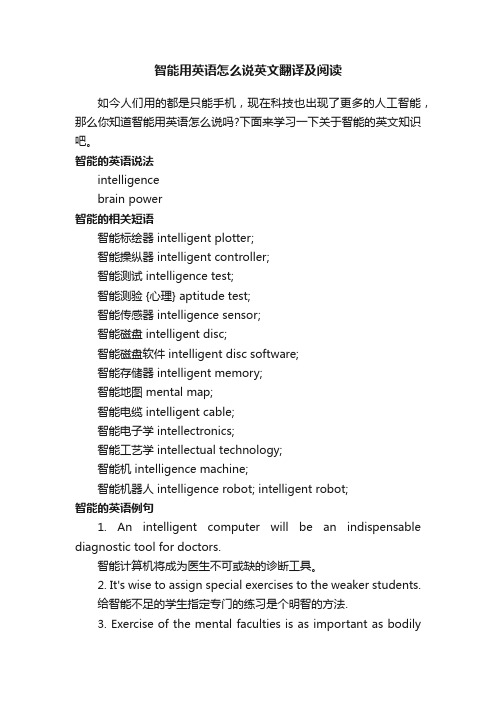
智能用英语怎么说英文翻译及阅读如今人们用的都是只能手机,现在科技也出现了更多的人工智能,那么你知道智能用英语怎么说吗?下面来学习一下关于智能的英文知识吧。
智能的英语说法intelligencebrain power智能的相关短语智能标绘器 intelligent plotter;智能操纵器 intelligent controller;智能测试 intelligence test;智能测验 {心理} aptitude test;智能传感器 intelligence sensor;智能磁盘 intelligent disc;智能磁盘软件 intelligent disc software;智能存储器 intelligent memory;智能地图 mental map;智能电缆 intelligent cable;智能电子学 intellectronics;智能工艺学 intellectual technology;智能机 intelligence machine;智能机器人 intelligence robot; intelligent robot;智能的英语例句1. An intelligent computer will be an indispensable diagnostic tool for doctors.智能计算机将成为医生不可或缺的诊断工具。
2. It's wise to assign special exercises to the weaker students.给智能不足的学生指定专门的练习是个明智的方法.3. Exercise of the mental faculties is as important as bodilyexcercise.智能的锻炼同身体的运动同样重要.4. Can the Web become a smart partner in scientific research?网络能称为科研的智能伙伴吗 ?5. And what's the price of this intelligent home?这种智能房屋的价格是多少 ?6. It represents the pinnacle of intellectual capability.它代表了智能的顶峰.7. Man's brain has given him enormous power in becominga significant environmental entity.智能给予人类以巨大的力量,使他成为重要的环境实体.8. Of a functional unit; intelligent; operating under the control of a stored program.对操作装置[ 功能单元 ]而言, 用于说明在一个存储程序控制之下运行的具有智能的特性.9. In summary, the IEEE - 488 bus represents quite an advancement in intelligent data acquisition systems.总之, IEEE—488 总线是智能数据采集系统中一个很大的改进.10. Doesn't the city center bus stop use smart buses?市中心公共汽车站不是使用智能公交吗 ?11. We're all painfully aware of your AI's limitations, captain.我们收到你的智能模拟的限制, 队长.12. Intelligence reports eleven scientists in the target area.智能报告有11个科学家在目标范围.13. In such a case, Commonwealth law demands that the AI's personality be completely erased.在这种情况下, 联邦法律要求这个智能机器人的性格特征被擦除.14. In Italy the majority of homes already have one.在意大利,大部分家庭都安装了智能表.15. An intelligent control method for operation of methanolrefining column was discussed.讨论用于甲醇生产主精馏塔改进工艺条件下的智能控制方法.关于只能的英文阅读:人们使用智能手机做什么呢?New research conducted by the mobile network O2 has found that people spend more time using their smartphones to surf the web, check social networks or play games, than to make actual phone calls, the Daily Telegraph reported.《每日电讯报》报道,英国移动企业O2公司最新调查结果显示,人们使用智能手机更多的是上网、看社交网络或玩游戏,而非打电话。
英语达标测试题及答案

英语达标测试题及答案1.take a photo答案:照相2.turn on答案:翻开(收音机,电视)3.turn off答案:关闭4.play back答案:倒带子5.e on答案:过来6.拿起,捡起答案:pick up7.爬出……答案:climb out of8.别担忧答案:don’t worry9.第二天答案:the next day10.挽救你的生命答案:save your life1.If the camera start,press the “camera” key.A.isn’tB.doesn’tC.don’t答案:B start是实义动词,且从句主语camera是第三人称单数,所以要用doesn’t 否认。
2.I will take a photo the house.A.ofB.inC.for答案:A take a photo of sb./sth.表示“给某人或某物照相”。
3.Mary,please show your picture.A.myB.mineC.ID.me答案:D 此题谓语动词后应接人称代词宾格作宾语,应选D。
4.There is someone at home because the lights are .A.outB.onC.not答案:B 因为看到房间里亮灯所以才判断有人,on可以表示“……正在工作”。
5.Please connect the digital camera the puter.A.toB.intoC.with答案:A connect sth.to sth.表示“把……和……连接起来”。
6.If you are the right place the right time,take a picture.A.in;atB.at;inC.at;at答案:A in the right place“在适宜的地方”,at the right time“在恰当的时间”。
英文职位
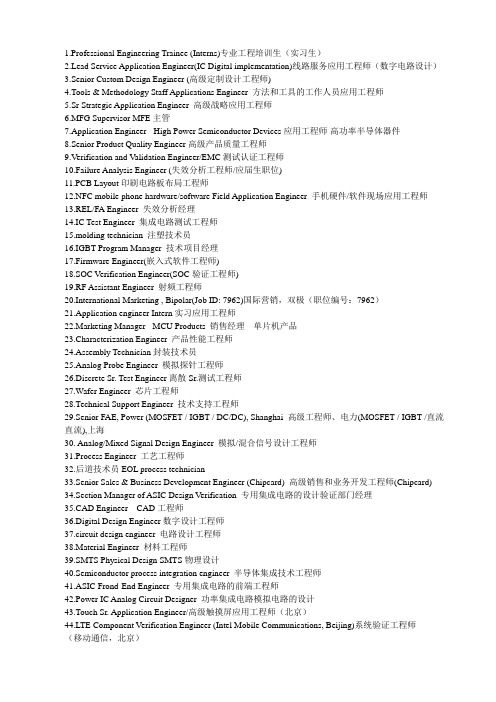
1.Professional Engineering Trainee (Interns)专业工程培训生(实习生)2.Lead Service Application Engineer(IC Digital implementation)线路服务应用工程师(数字电路设计)3.Senior Custom Design Engineer (高级定制设计工程师)4.Tools & Methodology Staff Applications Engineer 方法和工具的工作人员应用工程师5.Sr Strategic Application Engineer 高级战略应用工程师6.MFG Supervisor MFE主管7.Application Engineer - High Power Semiconductor Devices应用工程师-高功率半导体器件8.Senior Product Quality Engineer高级产品质量工程师9.V erification and V alidation Engineer/EMC测试认证工程师10.Failure Analysis Engineer (失效分析工程师/应届生职位)11.PCB Layout印刷电路板布局工程师12.NFC mobile phone hardware/software Field Application Engineer 手机硬件/软件现场应用工程师13.REL/FA Engineer 失效分析经理14.IC Test Engineer 集成电路测试工程师15.molding technician 注塑技术员16.IGBT Program Manager 技术项目经理17.Firmware Engineer(嵌入式软件工程师)18.SOC V erification Engineer(SOC验证工程师)19.RF Assistant Engineer 射频工程师20.International Marketing , Bipolar(Job ID: 7962)国际营销,双极(职位编号:7962)21.Application engineer Intern实习应用工程师22.Marketing Manager - MCU Products 销售经理---单片机产品23.Characterization Engineer 产品性能工程师24.Assembly Technician封装技术员25.Analog Probe Engineer 模拟探针工程师26.Discrete Sr. Test Engineer离散Sr.测试工程师27.Wafer Engineer 芯片工程师28.Technical Support Engineer 技术支持工程师29.Senior FAE, Power (MOSFET / IGBT / DC/DC), Shanghai 高级工程师、电力(MOSFET / IGBT /直流直流),上海30. Analog/Mixed Signal Design Engineer 模拟/混合信号设计工程师31.Process Engineer 工艺工程师32.后道技术员EOL process technician33.Senior Sales & Business Development Engineer (Chipcard) 高级销售和业务开发工程师(Chipcard)34.Section Manager of ASIC Design V erification 专用集成电路的设计验证部门经理35.CAD Engineer CAD工程师36.Digital Design Engineer数字设计工程师37.circuit design engineer 电路设计工程师38.Material Engineer 材料工程师39.SMTS Physical Design SMTS物理设计40.Semiconductor process integration engineer 半导体集成技术工程师41.ASIC Frond-End Engineer 专用集成电路的前端工程师42.Power IC Analog Circuit Designer 功率集成电路模拟电路的设计43.Touch Sr. Application Engineer/高级触摸屏应用工程师(北京)44.LTE Component V erification Engineer (Intel Mobile Communications, Beijing)系统验证工程师(移动通信,北京)45.高级FPGA工程师/Senior FPGA Engineer46.Lead Application Engineer –IP应用工程师–知识产权47.Experienced Digital Designer 有经验的数字设计师48.Senior FAE (高级现场应用工程师)49.Sr.Product and System Test Engineer(高级产品与系统测试工程师)50.Analog IC Design Engineer (电路设计工程师)51.ASIC Backend Design, Physical Design Engineer, 后端工程师52.Acoustic Engineer-Measurement 声学测试工程师53.Process Quality Engineer-质量工程师54.Synopsys IC Design Consultant(Frontend)/芯片设计顾问(前端)55.Synopsys IC Design Consultant(Backend)/芯片设计顾问(后端)56.电子&仪表主管Electronic & Instrument Supervisor-BJ57.售后服务工程师—Service Engineer Recruit58.高级硬件研发工程师(射频)Sr. Hardware Engineer (RF)59.Qualification and Certification Engineer - Set Top Box 资格鉴定和认证工程师——机顶盒60.硬体应用工程师Hardware Applications Engineer61.电子电气工程师Electric & electronic engineer62.、Sr Facilities Maintenance Tech - 00177944 高级设施维修技术0017794463.Field Application Engineer, RF& Wireless 射频微波现场技术支持工程师64.电源设计工程师Electrical Power Design Engineer65.Embedded Software Engineer-Mobility Android 嵌入式软件engineer-mobility机器人66.SoC Physical Design 片上系统物理设计一、Technical Support Engineer 技术支持工程师1、弱电工程、通信或计算机相关专业毕业;2、有良好的语言表达能力和娴熟的沟通技巧,普通话标准;3、对小区智能化、安防、智能家居技术有较深的了解,熟悉行业产品应用和相关技术规范;4、有若干小区智能化工程设计、施工经验;5、有组织管理能力。
fif英语测试系统fif测试系统答案

fif英语测试系统fif测试系统答案
为了帮助您解决“fif口语训练app怎么样?fif口语训练功能特色介绍”相关的问题,学网通过互联网对“fif口语训练app 怎么样?fif口语训练功能特色介绍”相关的解决方案进行了整理,用户详细问题包括:RT,我想知道:fif口语训练app怎么样?fif口语训练功能特色介绍,具体解决方案如下:下面是范文网在
线.01hn.WTT整理的fif测试系统答案,供大家参考!
fif测试系统答案
为了帮助您解决“fif口语训练app怎么样?fif口语训练功能特色介绍”相关的问题,学网通过互联网对“fif口语训练app 怎么样?fif口语训练功能特色介绍”相关的解决方案进行了整理,用户详细问题包括:RT,我想知道:fif口语训练app怎么样?fif口语训练功能特色介绍,具体解决方案如下:
解决方案1:
fif口语训练app是一款练习英语的软件,并且fif口语训练是与各大高校合作,形成了老师可以布置口语的训练的作业,学生直接在这款软件上进行口语作业的完成,那么fif口语训练的功能有哪些?
fif口语训练app学生版的功能特点:
1、及时完成教师口语任务,主动开展口语自主训练;
2、激励式学习模式设计,激发学生学习动机;
3、获得多维度即时反馈,清晰诊断发音问题;
4、手机端随时随地训练,便捷高效移动学习。
fif口语训练教师版功能介绍:
1、及时完成教师口语任务,主动开展口语自主训练;
2、激励式学习模式设计,激发学生学习动机;
3、获得多维度即时反馈,清晰诊断发音问题;
4、手机端随时随地训练,便捷高效移动学习。
网速英语怎么说

网速英语怎么说网速一般是指电脑或手机上网时,上传和下载数据时,请求和返回数据所用的时间长短。
那么你知道网速用英语怎么说吗?接下来跟着来学习一下吧。
网速的英语说法1:internet speed网速的英语说法2:network speed网速的英语说法3:Speedroad网速相关英语表达:网速不好Internet speed is bad网速测试Net Speed Test Lite网速监控NetSpeed Monitor网速的英语例句:1. M: The slow connection speed puts ones in a pickle.网速太慢可真让人头痛.2. It won so many customers that other operators had to follow suit.这样拉拢来许多顾客,而其他运营商也不得不提高网速.3. Not a good speed, play any games are to no avail!没有良好的网速, 玩什么游戏都是枉然!4. TD using video monitoring, speed can reach 2 M per second capacity.采用TD视频监控, 网速能达到每秒钟2M量.5. The likelihood is a net fast problem, you can retry later try.可能是网速问题, 你可以稍后再试试.6. In the beginning, the few people on LTE will see blazing speeds.在刚开始的时候, 使用LTE的少量用户将享受超高的网速.7. Therefore, when the network equipment hardware failure will lead to slow - network.因此, 当网络设备硬件有故障时也会引起网速变慢.8. In terms of speed, Japan leads the world.日本的宽带网速最快.9. Compere: Besides the net fast besides the element, what is the greatest now difficulty?主持人: 除了网速的因素之外, 现在最大的困难是什么?10. This has kept international phone calls horribly overpriced and internet access equally and maddeningly slow.这导致了该地区国际电话费价格过高,网络收费居高不下,且网速慢得让人抓狂.11. Have used the key associating one recover being able to make net speed change slow?用了联想一键恢复会不会使网速变慢?12. Gain ground as net net fast faster and faster, broadcast hears on the net unchallenged already.随着宽带网普及,网速越来越快, 网上听广播已不成问题.13. The software also features a system of highly customizable visual and sound alerts.同时该软件提供了高效的图网速监控软件下载形界面伴唱音提示.14. Because at that time net fast very slow, somebody is disinclined to fall one by one!因为当时网速很慢, 有人懒得一个一个的下!15. The failing of this method is the game speed will slow if one client slow.不足之处在于如果某台客户端的网速较满,则导致整个游戏的速度变慢.。
初中英语常用缩写归纳

ADSL Asymmetrical Digital Subscriber Line 又名网络快车。
APEC Asian-Pacific Economic Cooperation 即亚太经济合作组织。
AQ Adversity Quotient逆境商数. CATV Cable Television即有线电视BBS Bulletin Board System 公告牌系统或电子公告板。
BSS Base Station System 即基站系统,指移动通信中的空中接口部分。
CARM Chinese Association of Rehabilitation Medicine即中国康复医学会。
CBD Central Business District又称中央商务区。
CCEL China Certification Committee for Environment Labelling Production即中国环境标志产品认证委员会。
CD-ROM Compact Disk-Read Only Memory即光盘只读存储器即光驱。
CEO Chief Executive Officer即首席执行官。
CET College English Test即大学英语测试。
CFO Chief Finance Officer即首席财务主管。
CI Corporate Identity即企业形象统一战略,CID Central Information District即中央信息区。
CIO Chief Information Officer即首席信息主管,也称信息中心主任。
CPA Certified Public Accountant即注册会计师CPI Consumer Price Index,即全国居民消费价格指数。
CPU Central Processing Unit又称微处理器,CS customer satisfaction 顾客满意度。
手机的英文是什么
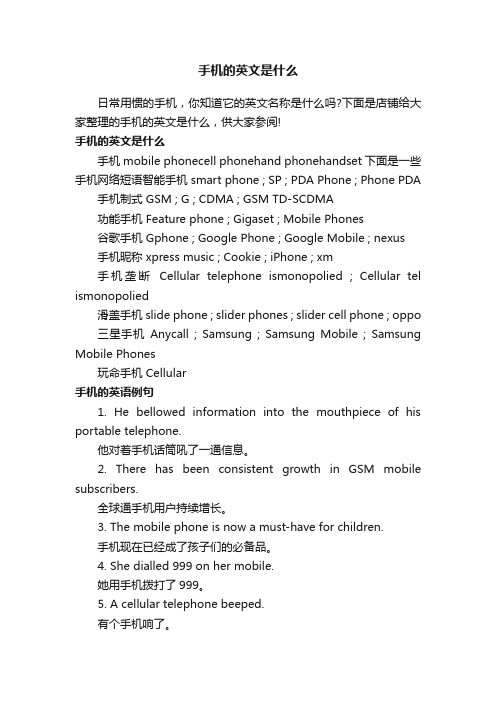
手机的英文是什么日常用惯的手机,你知道它的英文名称是什么吗?下面是店铺给大家整理的手机的英文是什么,供大家参阅!手机的英文是什么手机 mobile phonecell phonehand phonehandset下面是一些手机网络短语智能手机 smart phone ; SP ; PDA Phone ; Phone PDA 手机制式 GSM ; G ; CDMA ; GSM TD-SCDMA功能手机 Feature phone ; Gigaset ; Mobile Phones谷歌手机 Gphone ; Google Phone ; Google Mobile ; nexus手机昵称 xpress music ; Cookie ; iPhone ; xm手机垄断Cellular telephone ismonopolied ; Cellular tel ismonopolied滑盖手机 slide phone ; slider phones ; slider cell phone ; oppo 三星手机Anycall ; Samsung ; Samsung Mobile ; Samsung Mobile Phones玩命手机 Cellular手机的英语例句1. He bellowed information into the mouthpiece of his portable telephone.他对着手机话筒吼了一通信息。
2. There has been consistent growth in GSM mobile subscribers.全球通手机用户持续增长。
3. The mobile phone is now a must-have for children.手机现在已经成了孩子们的必备品。
4. She dialled 999 on her mobile.她用手机拨打了999。
5. A cellular telephone beeped.有个手机响了。
wetest智能测试系统应用研究

wetest智能测试系统应用研究摘要:Wetest智能测试系统可以用于学生的课堂测验、期末考试等,为教师提供快速、准确、全面的学生评估数据。
此外,Wetest智能测试系统还可以为学生提供智能化的学习建议和个性化的学习计划,帮助学生更好地提高学习成绩。
关键词:Wetest,智能测试,英语Wetest智能测试系统是上海外语教育出版社在有效吸收先进外语测试理念、融合当前国内外最新技术手段、全面整合有效资源的基础上,全新打造的集海量题库、智能组卷、在线考试、机器阅卷、成绩统计分析于一体,面向各层次外语考试的计算机辅助外语测试系统。
系统针对现代外语教育特点,为学校外语考试及日常训练量身定制,基于因特网运行。
其主要设计目标是为各类学校外语网络考试提供一个统一的基础性服务系统。
借助这个系统,学校既可以组织大规模的期中期末考试或小规模的班级测试,也可以让学生自由上机进行自测,以达到课后、考前灵活练习、备考的目的。
WE Test系统主要由组卷子系统、机阅子系统、在线考试子系统三大部分组成,使得传统考试中组卷、考试、阅卷、分数统计等费时费力的过程得以高效解决,极大减轻了教师的工作量。
系统所配试题,涵盖听、说、读、写、视频等各种题型共计60余种,覆盖大学英语、英语专业、高职英语等各种层级,既包含水平测试题库,也包含课程测试题库。
WE Test 智能测试系统分为六大主要板块:1)我的账户:包含了个人信息、密码修改、我的套餐、短消息、操作记录、问题反馈等子菜单。
2) 自建题库:用户可录入自己的试题,支持所有常用考试题型3) 组卷中心:包括用户自组试卷、推荐试卷。
4)在线考试:组织在线考试,实现无纸化,自动批阅学生答卷生成考试报表;5)机阅考试:纸笔考试配合机器阅卷,极大提高阅卷效率,节省人力成本;WE Test为解决大规模纸笔考试中的阅卷工作量大、实施成本高、存档不便等痛点问题,专门开发了机器阅卷全新解决方案,该机阅系统可协助教师完成纸笔考试的阅卷工作,并对考试进行全流程管理。
常用英文缩写大全-资料类
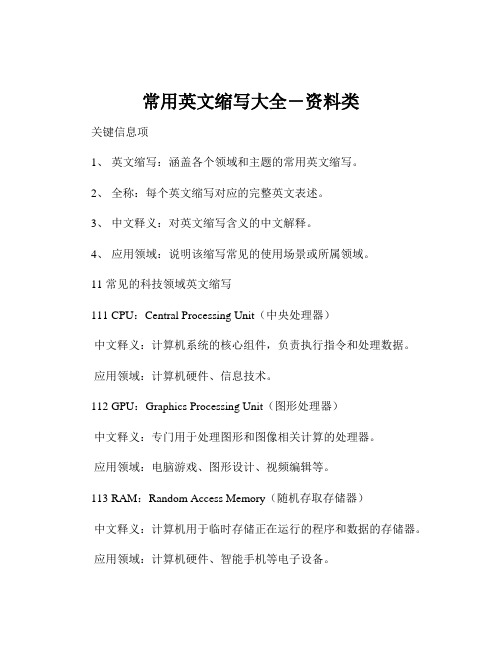
常用英文缩写大全-资料类关键信息项1、英文缩写:涵盖各个领域和主题的常用英文缩写。
2、全称:每个英文缩写对应的完整英文表述。
3、中文释义:对英文缩写含义的中文解释。
4、应用领域:说明该缩写常见的使用场景或所属领域。
11 常见的科技领域英文缩写111 CPU:Central Processing Unit(中央处理器)中文释义:计算机系统的核心组件,负责执行指令和处理数据。
应用领域:计算机硬件、信息技术。
112 GPU:Graphics Processing Unit(图形处理器)中文释义:专门用于处理图形和图像相关计算的处理器。
应用领域:电脑游戏、图形设计、视频编辑等。
113 RAM:Random Access Memory(随机存取存储器)中文释义:计算机用于临时存储正在运行的程序和数据的存储器。
应用领域:计算机硬件、智能手机等电子设备。
114 ROM:ReadOnly Memory(只读存储器)中文释义:存储固定数据和程序的存储器,内容通常无法修改。
应用领域:计算机系统、电子设备的固件存储。
12 商务和金融领域的英文缩写121 CEO:Chief Executive Officer(首席执行官)中文释义:公司或组织的最高行政负责人。
应用领域:企业管理、商业报道。
122 CFO:Chief Financial Officer(首席财务官)中文释义:负责公司财务规划和管理的高级管理人员。
应用领域:企业财务管理、金融领域。
123 IPO:Initial Public Offering(首次公开募股)中文释义:公司首次向公众出售股份以筹集资金。
应用领域:金融市场、股票发行。
124 GDP:Gross Domestic Product(国内生产总值)中文释义:一个国家或地区在一定时期内生产的所有最终产品和服务的市场价值总和。
应用领域:经济分析、宏观经济研究。
13 教育领域的英文缩写131 TOEFL:Test of English as a Foreign Language(托福考试)中文释义:用于评估非英语母语者英语能力的标准化考试。
常见英语缩写
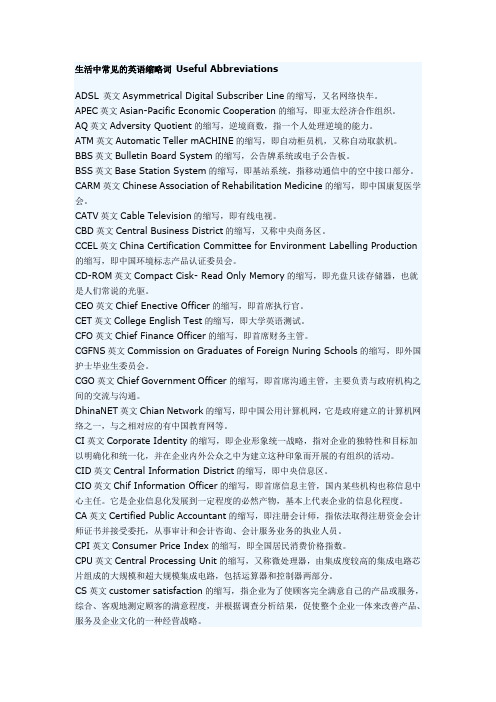
生活中常见的英语缩略词Useful AbbreviationsADSL 英文Asymmetrical Digital Subscriber Line的缩写,又名网络快车。
APEC英文Asian-Pacific Economic Cooperation的缩写,即亚太经济合作组织。
AQ英文Adversity Quotient的缩写,逆境商数,指一个人处理逆境的能力。
ATM英文Automatic Teller mACHINE的缩写,即自动柜员机,又称自动取款机。
BBS英文Bulletin Board System的缩写,公告牌系统或电子公告板。
BSS英文Base Station System的缩写,即基站系统,指移动通信中的空中接口部分。
CARM英文Chinese Association of Rehabilitation Medicine的缩写,即中国康复医学会。
CATV英文Cable Television的缩写,即有线电视。
CBD英文Central Business District的缩写,又称中央商务区。
CCEL英文China Certification Committee for Environment Labelling Production 的缩写,即中国环境标志产品认证委员会。
CD-ROM英文Compact Cisk- Read Only Memory的缩写,即光盘只读存储器,也就是人们常说的光驱。
CEO英文Chief Enective Officer的缩写,即首席执行官。
CET英文College English Test的缩写,即大学英语测试。
CFO英文Chief Finance Officer的缩写,即首席财务主管。
CGFNS英文Commission on Graduates of Foreign Nuring Schools的缩写,即外国护士毕业生委员会。
CGO英文Chief Government Officer的缩写,即首席沟通主管,主要负责与政府机构之间的交流与沟通。
手机行业英语
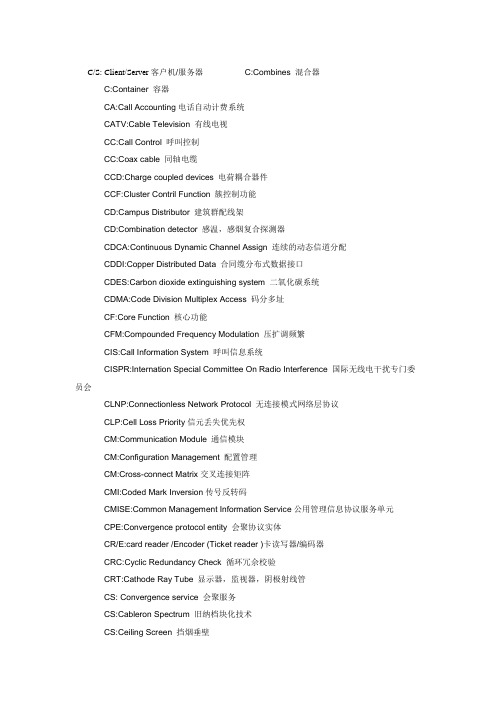
C/S: Client/Server客户机/服务器C:Combines 混合器C:Container 容器CA:Call Accounting电话自动计费系统CATV:Cable Television 有线电视CC:Call Control 呼叫控制CC:Coax cable 同轴电缆CCD:Charge coupled devices 电荷耦合器件CCF:Cluster Contril Function 簇控制功能CD:Campus Distributor 建筑群配线架CD:Combination detector 感温,感烟复合探测器CDCA:Continuous Dynamic Channel Assign 连续的动态信道分配CDDI:Copper Distributed Data 合同缆分布式数据接口CDES:Carbon dioxide extinguishing system 二氧化碳系统CDMA:Code Division Multiplex Access 码分多址CF:Core Function 核心功能CFM:Compounded Frequency Modulation 压扩调频繁CIS:Call Information System 呼叫信息系统CISPR:Internation Special Committee On Radio Interference 国际无线电干扰专门委员会CLNP:Connectionless Network Protocol 无连接模式网络层协议CLP:Cell Loss Priority信元丢失优先权CM:Communication Module 通信模块CM:Configuration Management 配置管理CM:Cross-connect Matrix交叉连接矩阵CMI:Coded Mark Inversion传号反转码CMISE:Common Management Information Service公用管理信息协议服务单元CPE:Convergence protocol entity 会聚协议实体CR/E:card reader /Encoder (Ticket reader )卡读写器/编码器CRC:Cyclic Redundancy Check 循环冗佘校验CRT:Cathode Ray Tube 显示器,监视器,阴极射线管CS: Convergence service 会聚服务CS:Cableron Spectrum 旧纳档块化技术CS:Ceiling Screen 挡烟垂壁CS:Convergence Sub layer合聚子层CSC:Combined Speaker Cabinet 组合音响CSCW:Computer supported collaborative work 计算机支持的协同工作CSES:Continuius Severely Errored Second 连续严重误码秒CSF:Cell Site Function 单基站功能控制CTB:Composite Triple Beat 复合三价差拍CTD:Cable Thermal Detector 缆式线型感温探测器CTNR:carrier to noise ratio 载波比CW:Control Word 控制字D:Directional 指向性D:Distortion 失真度D:Distributive 分布式DA:Distribution Amplifier 分配的大器DBA:Database Administrator数据库管理者DBCSN:Database Control System Nucleus数据库控制系统核心DBOS:Database Organizing System 数据库组织系统DBSS:Database Security System 数据库安全系统DC:Door Contacts大门传感器DCC:Digital Communication Channel数字通信通路DCN:Data Communication Network 数据通信网DCP-I:Distributed Control Panel -Intelligent智能型分散控制器DCS:Distributed Control System集散型控制系统DDN:Digital Data Network 数字数据网DDS:Direct Digital Controller直接数字控制器DDW:Data Describing Word 数据描述字DECT:Digital Enhanced Cordless Telecommunication增强数字无绳通讯DFB:Distributed Feedback 分布反馈DID:Direct Inward Dialing 直接中继方式,呼入直拨到分机用户DLC:Data Link Control Layer 数据链路层DLI:DECT Line InterfaceDODI:Direct Outward Dialing One 一次拨号音DPH:DECT PhoneDRC:Directional Response Characteristics 指向性响应DS:Direct Sound 直正声DSP:Digital signal Processing 数字信号处理DSS:Decision Support System 决策支持系统DTMF:Dual Tone Multi-Frequency 双音多频DTS:Dual -Technology Sensor 双鉴传感器DWDM:Dense Wave-length Division Multiplexing 密集波分复用DXC:Digital Cross-Connect 数字交叉连接E:Emergency lighting照明设备E:Equalizer 均衡器E:Expander 扩展器EA-DFB:Electricity Absorb-Distributed Feedback 电吸收分布反馈ECC:Embedded Control Channel 嵌入或控制通道EDFA:Erbium-Doped Fiber Amplifier掺饵光纤放大器EDI:Electronic Data Interexchange 电子数据交换EIC:Electrical Impedance Characteristics 电阻抗特性EMC:Electro Magnetic Compatibility 电磁兼容性EMI:Electro Magnetic Interference 电磁干扰EMS:Electromagnetic Sensibility 电磁敏感性EN:Equivalent Noise 等效噪声EP:Emergency Power 应急电源ES:Emergency Sooket 应急插座ES:Evacuation Sigvial疏散照明ESA:Error SecondA 误码秒类型AESB:ErrorSecondB 误码秒类型BESD:Electrostatic Discharge静电放电ESR:Errored Second Ratio 误码秒比率ETDM:Electrical Time Division Multiplexing电时分复用ETSI:European Telecommunication Standards Institute欧洲电信标准协会点图进入相册我们的最先进工艺技术铝锻铝合金锻造锻压手机外壳成品加工....OUR NEW PRODUCTS Aluminum alloy forging handset cell phone body cover housing manufacture in china by alloy seiko industry co.,ltd.点图进入相册我们的最先进工艺技术铝锻铝合金锻造锻压手机外壳成品加工....OUR NEW PRODUCTS Aluminum alloy forging handset cell phone body cover housing manufacture in china by alloy seiko industry co.,ltd.直板手机bar phone翻盖手机clamshell phone /flip phone滑盖手机slide phone对讲机Walkie-Talkie全球定位系统GPS (Global Positioning System)高保真high fidelity(常简写为hi-fi)移动梦网Monternet(Mobile+Internet)短信服务SMS(Short Message Service)彩信服务MMS(Multimedia Message service)客户身份识别卡SIM卡(Subscriber Identity Module)全球移动通信系统GSM (Global System For Mobile Communications)储值卡pre-paid phone card语音提示voice prompt直板手机bar phone翻盖手机clamshell phone /flip phone滑盖手机slide phone翻盖接听flip answer按键keypad按键音keypad tone提示音warning tone手机充值cellular phone replenishing/recharging手机入网费initiation charges for mobile phone; mobile access fee漫游roaming service手机用户mobile phone user/subscriber短信short message; text message图片短信picture message手机费mobile phone fee关机power off手机铃音mobile phone ringtone振动vibrate手机实名制mobile phone identification policy双向收费two-way charging scheme彩屏color screen壁纸wallpaper待机模式standby mode操作菜单options菜单模式list view/ grid view快捷图标short-cut icon自动重拨automatic redial快速拨号speed dial语音拨号voice dial任意键应答any key answer限制呼叫fixed dial呼出通话outgoing call被叫通话incoming call近来的呼叫recent call呼叫转移call divert未接电话missed call已接电话received call不在服务区out of reachA:ADC: 模拟/数字转换ADSL: 不对称数字用户线AFC:自动频率控制AFCDAC:数模转换输出AGC: 自动增益控制AGND:模拟地AID:区域识别标志ALARM: 告警AM: 调幅AMPLIFIER: 放大器AMPS:先进的移动电话系统ANALOG: 模拟ANALOGON:音频逻辑控制启动ANT:天线AOC: 自动输出控制(MOTO专用)APC: 自动功率控制APC:音频处理芯片ARFCH: 绝对信道ASDI:辅助数据输入ASDIFS:辅助数据输入选通ASDCLK:辅助接口时钟信号ASDO:辅助数据输出ASDOFS:辅助数据输出选通ASIC: 专用接口集成电路AST-DET: 饱和度检测AUC:鉴权中心AUX: 辅助AUXADC3:外部AD转换输入3AUXADC4:外部AD转换输入4AUDIO: 音频AVDD:模拟电路供电AFMS(AUDIO FROM MS): 来自手机的音频ATMS(AUDIO TO MS): 去向手机的音频B:BASE: 基极BASE BAND<BB>: 基带BATT-ID:电池类型BATT-TEMP:电池温度BATTP:电池温度测量BBC:基带编解码器BCH: 广播信道BCP:基带串口BDR:语音信道编码信息,接收资料信号BDX:语音信道的编码信息BFRX:控制信道的编码信息,发射同步信号BFSR:音频接收同步信号BFSX:软化射频I/O信号或音频数字信号送CPU BIAS: 偏压BIPOLAR TRANSISTORE: 双极晶体管BIST:内置自测BLUE TOOTH<BT>: 蓝牙BOOT: 屏蔽罩BPF:带通滤通器BREFCAP:基带参考藕合电容BREFOUT:基带参考电压输出BS: 基站BSC: 基站控器BTS: 基站收发器BSCLK:接收时钟信号BSCLK:基带接口时钟信号BSD:接收数字信号BSDI:基带接口数据输入BSDO:接收数字信号BSDO:基带接口数据输出BSDIFS:基带接口数据输入选通BSDOFS:基带接口数据输出选通BSIFS:接收同步信号BSOFS:接收同步信号BSW:频段落选择信号BUS:总线BUZZER:振铃信号C:CAR:电源控制、音频、振铃模块CAPACITY: 电容CCD:电荷耦合器件<即摄像头>CCIO:数据通信器CCIOSW:数据通信口开关CCONTCSX: 维持信号<NOKIA专用>CDMA<CIDE DIVISION MULTIPLE ACCESS>: 码分多址CHARGE<CHRG>:充电CHRGRON:充电启动CHARGEUR:充电电源CHIDENT:充电中断信号CKMIW:时钟和片选信号CLK:时钟信号CLKBM:CPU系统时钟输入CLOCKM:时钟管理CMDDS:测量启动信号CMDCH:充电控制信号CMDVIB:振动控制信号CODEC: 编/译码器COL: 列COLLECTOR: 集电极CONVERTER: 转换器<三星>CONTROL: 控制CPIFSYN:二本振锁相控制信号输出CPRFSYN:一本振锁相控制信号输出CPU< CENTRAL PROCESSING UNIT>: 中央处理器CRYSTAL: 晶体CSLCDGLRESETLCD:用一控制LCD显示CSSRAM:暂存片选信号D:DAI:数字音频接口DATA:数据信号DCS1800M<DIGITAL CELLULAR SYSTEM AT 1800M>: 1800M数字蜂窝系统DCS-SEL:1800MHz频段选择DCT3<DIGITAL CORE TECHNOLOGY 3RD GENERATION>: 第3代数字核心技术 DEBUG-RX:调试数据接收DEBUG-TX:调试数据发射DET: 检测.如:SIM-DET.DEMOD M: 解调DGND:数字电路地DFMS<DATA FROM MS>;来自手机的数据DIGITL:数字DIODE: 二极管DIPLEXER: 双工器DM-CS: 低通-翻转,片选信号<MOTO专用>DMT:并行多路测试DOMIW:是CPU输出的扫描控制D-REG: 数字调整电压DRAM: 动态存储器DSP<DIGITAL SIGNAL PROCESSOR>: 数字信号处理DSR:测试端口DTMF: 双音多频DTMS<DATA TO MS>: 去向手机的数据DUPLEX: 双工器,即合路器E:EARN:(耳机)负EARP:(耳机)正ECHO CANCEL: 回声抑制功能EFR<ENHANCED FULL RATE>: 扩展的全速率<NOKIA专用>EL<ELECTRO-LUMINESCENT LIGHTING>: 电激发光板<片>.EMC<ELECTROMAGNETIC COMPATIBILITY>: 电磁互换EMI: 电磁干扰EMS: 增强型短信服务<文本+音调+图片+声音+动画>.<比SMS优秀>.EMITTER: 发射极ENRF134:射频频率合成模块启动ENOMEGAMN1:芯片功能启动信号EQUALIZER: 均衡器ESN<ELECTRONIC SN>: 电子序列号.ETACS: 增强型全接入移动通信系统EXC: 外部EXT: 外部F:FACCH: 快速随路控制信道FCH: 频率校正信道FCCH:频率较正信道FDMA<FREQUENCY DIVISION MULTIPLE ADDRESS>: 频分多址FEED-BACK<FDBK>: 反馈FER: 误码率FET<FIELD EFFECT TRANSISTOR>: 场效应管FILTER<FL>: 滤波器FLIP: 翻盖FLOCK:本振锁定控制信号FM: 调频FSK: 移频键控G:GAIN: 增益GMSK: 高斯最小频移键控GPRS<GENERAL PACKET RADIO SERVICE>: 通用无线分组业务GPS:全球导航定位系统GRID: 栅极GSM<GLOBAL SYSTEM FOR MOBILE COMMUNICATIONS>: 全球移动通讯系统.GSM<GLOBAK SYSTEM MOBILE COMMUNICATION>: 900MGSM-SEL:900MHS频段选择信号H:HAMONIC FILTER:谐波滤波器HANDOFF:切换HAND-OFF:越区转接HEAD-INT:耳机请求信号HLR:归属位置寄存器HOOK: 免提HPF:高通滤波器HS<HALF RATE SPEECH>: 半速率I:I: 同相支路IC<INTEGRATED CIRCUIT>: 集成电路IF<INTERMEDIATE FREQUENCY>: 中频IFIN:中频信号输入(正)IFINB:中频信号输入(负)ILLEGAL SOFTWARI LOADED: 非法软件下载IMEI<INTERNATIONAL MOBILE EQUIPMENT IDENTIT中断Y>: 国际移动设备识别码INDUCTANCE: 电感INITIAL:初始INT<INTERRUPT>: 中断INTH:中断管理器INT?C:按键中断判断口INTERFACE: 界面I/O:数据输入/输出IRXP:接收I信号(正)IRXN:接收I信号(负)IRDA<INFRARED RAY>: 红外线ISDN: 综合业务数字网ITXP:发射基带I信号(正)ITXN:发射基带I信号(负)ITWADEVP:时钟(闹钟)开机控制信号IWF:各种业务功能接口J:JACKEN:耳机启动信号K:KEYLIGHT:键盘灯L:LAN<LOCAL AREA NETWORK>: 局域网LANG:低噪声放大器增益控制信号LNAON:低噪声放大器启动信号LCD<LIQUID CRYSTAL DISPLAY>:液晶显示器LE:频率合成器使能信号LED<LIGHT EMITTING DIODE>: 发光二极管LEVEL: 电平LIGHTKEY:按键背景灯控制信号LNA<LOW NOISE AMPLIFIER>: 低噪放大器LOCK: 锁定LOGIC: 逻辑LOOP: 环路LOOP FLITER: 环路滤波器LPF:低通滤波器LSDN<LOCAL SERVICE DIGITAL NETWORK>:本地业务数字网M:MANUAL TEST:人工测试MCLK:主时钟MCU<MICRO CONTROLLER UNIT> : 微处理单元(中央处理器)MDM: 调制/解调器(MOTO专用)MENU: 菜单MESVBATUBAT:测量电压MF: 陶瓷滤波器MIC:麦克风MIDI<MUSICAL INSTRUMENT DIGITAL INTERFACE>: 乐器数字接口MIX1OUT:第一混频器输出(正)MIX1OUTB:第一混频器输出(负)MIX2OUT:第二混频器输出(正常)MIX2OUTB:第二混频器输出(负)MIXIDCSINB:1800MHz混频器输入(负)MIXIDCSIN: 1800MHz混频器输入(正)MMS<MULTIMEDIA MESSAGE SERVICE>: 多媒体短消息服务/即彩信<第三代短消息> MMC<MULTIMEDIA CARD>: 多媒体卡MOBILE: 移动MOBILE-SWITCH: 移动交换机MOD: 调制MODEM:调制/解调器MODE:模式MODFREQ:调制菜单MODULATION TYPE:调制类型MP3:MPEG LAYER 3: 一种声音压缩格式,压缩比可达1:12MPU: 主处理单元MRESPWROIN:CPU上电复位信号输入MSC<MOBILE SEITCH CENTRAL>: 移动交换中心MS<MOBILE SET>: 移动台MSC: 移动交换中心MSIN: 移动台识别码MSK: 最小频移键控MSN: 设备制造号码MSRN: 漫游MUTE: 静音N:NBSSCAX:扫描选择NC: 悬空NEG<NEGATIVE>: 负压NETWORK: 网络O:OCE:使能信号OEL:待机状态下FLASH数据输出使能端OFST: 偏置OLED<ORGANIC LIGHT-EMITTING DIODE>: 有机发光二极管ONSRQ: 免提开关控制OSC:振荡器OSCILLATE: 振荡OUIL:开机信号ONRADIO:控制射频电压产生信号P:PA:功率放大器PA-ON:发射启动信号PA-LEVEL:功率等级信号PAS<PERSONAL ACCSS PHONE SYSTEM>: 无线市话/小灵通/个人通信接入系统PCB: 印刷电路板PCH: 寻呼信道PCHAR:充电维持信号PCM<PULSE CODE MODULATION> : 脉冲编码调制PCN<PERSONAL CIMMUNICATIONS SERVICE>: 个人通信服务(也指其使用的1800M频率) PD/PH/PHD<PHASE DETECTOR>: 鉴相器PDATA: 并行数据PDA<PERSONAL DIGITAL ASSISTANT>: 个人数字助理PHASE: 相位PHS<PERSONAL HANDY-PHONE SYSTEM>: 无线市话/小灵通<日本名称>PIN<PERSONAL IDENTIFICATION NUMBER>: 个人识别码<保存在卡中,错则手机不能使用,允许输错三次> PIN2码用于设定如通话计费等的特殊功能,如被锁住不会影响其他功能的使用.PK PEAK:峰值PLL<PHASE LOCKDE LOOP>: 锁相环PLLOUT:锁相环控制电压输出POLY: 和弦PROTECT: 保护PUK: SIM卡锁的解锁密码. <允许输错10次,错则卡永久报废>PUMP: 激励/泵/电荷泵PVEF:开关机状态寄存器激活信号PWM<PULSE WEIDTH MODULATION> : 脉冲宽度调制PWRON:电源开关PWRHOLD:电源保持PWRKEY:电源健控信号Q:Q: 正交支路QRXP:接收Q信号(正)QRXN:接收Q信号(负)QTXP:发射基带Q信号(正)QTXN:发射基带Q信号(负)QUARTZ CRYSTAL: 石英晶体R:RADIO-TEMP:射频温度检测电路RAMP:功率基准控制信号RECEIVER:听筒信号REED: 干簧管REF: 参考RESCAP:复位信号延时电容RESET:复位RESETLCD:显示屏复位信号RESISTANCE: 电阻RF<RADIO FREQUENCY>: 射频RF-LO:一本振RF-SW:天线开关RF2V8:射频供电2.8VRIF:射频接口功能ROAMING: 漫游ROW: 行RPE-LTP:语音编解码RSLCD:控制LCD对比度的信号RSSI<RECEIVE SIGNAL STRENGTH INDICATION>: 接收场强.接收信号强度指示RTC<REAL TIME CONTROL>: 实时时钟控制RWLCD:显示屏读写控制信号RXD:串行数据接收RXON:接收启动RXIP:接收I信号(正)RXIN:接收I信号(负)RXQP:接收Q信号(正)RXQN:接收Q信号(负)S:SAT-DET<SATURATION>: 饱和度检测SCH: 同步信道SCLEEP E?PROM:码片时钟线SCLI?C:I?C总线时钟线SCOKET: 接口SDAEEP E?PROM:码片数据线SDATA:频率合成器串行数据线SERCLD:去射频时钟线SERDAT:去射频数据线SERIAL: 串行SERVICE LEVEL:服务等级SENSE: 传感器SHIFT: 移相电路SHORTCUT: 短路SIM<SUBSCRIBER IDENTIFY MODULE>: 用户识别模块SIMBAT:SIM 电源SIMGND:SIM卡电路地SIM-I/O:卡数据输入输出信号SIMON:VSIM电源开关SIMPRDG:VSIM 程序控制SIM-RST:SIM卡复位信号SLEEP: 睡眠,休眠SMOC: 数字信号处理器(MOTO专用)SMS<SHORT MESSAGE SERVICE>:短消息SW-VCC:开关供电SPEAKER:喇叭SPI: 串行外围接口SRAM: 静态随机存储器SRAM:暂存器STK<SIM TOOL KIT>: 用户识别应用开发工具STN<SUPER TWISTED NEMATIC>:超扭曲向列型液晶显示屏幕<属反射式LCD,黑暗时清晰度差>STR<START>: 启动信号(如SYN-STR)SWDC: 未调整电压(MOTO专用)SYN<SYNTHESIZER>: (频率)合成SYN-CLK:频率合成时钟信号T:TACS: 全接入移动通信系统TANK: 回路TCH: 话音通道TCXO: 温度补偿型晶振TDMA<TIME DIVISION MULTIPLEX ACCESS>:时分多址TD-SCDMA: 时分同步多址<中国提出的第三代移动通信标准>TEMP: 温度TFD<THIN FILM DIODE>: 薄膜二极管半透式液晶显示器<在反射式/透射式下均能提供高清晰度的显示>TFT<THIN FILM TRANSISTOR>: 薄膜晶体管型液晶显示器<目前最好的>THERM: 温度检测TRANSFER: 转移TSC: 触摸屏TDI-测试信号输入TSO:测试信号输出TCK:测试时钟信号TMS:测试模式控制TXD:串行数据发送TXONPA:发射功放启动TSP:时?串口TAP:测试口TPU:时间处理单元TX:发信TCXO:温度补偿晶体振荡器TS:时隙TEMPRAD:主板温度测量信号TUNING:调谐U:UEM<UNIVERSAL ENERGY MANAGEMENT>: 通用电源管理器<NOKIA专用> UHF: 超高频UI<USER INTERFACE>: 用户模组ULPD:超低功率器件UPDATD: 升级UP-LINK: 上行链路UPP<UNIVERSAL PHONE PROCESSOR>: 通用电话处理器<NOKIA专用>V:VALONVCO:开机维持信号VBATT:电池电压VBC:音频数字信号编解码器VCAP+:升压电容(正)VCAP-:升压电容(负)VCCA:模拟供电VCCCOMP:鉴相器供电VCCPLL:锁相环低噪声放大器供电VCK:音频接收发送的时钟信号VCO<VOLTAGE CONTROLLED OSCILLATOR>: 压控振荡器VCP:语音串行口VCXO<VOLTAGE CONTROLLED CRYSTAL OSCILLATOR>: 压控晶体振荡器 VDX:音频发送数据传输信号VDR:音频接口数据传输信号VF: 电池电量检测(三星)VFS:音频数据接收发送选择信号VHF:甚高频VINNORP:音频信号输入正(MIC)VINNORN:音频信号输入负(MIC)VINAUXP:音频信号外部输入正(外部MIC信号)VINAUXN:音频信号外部输入负(外部MIC信号)VOUTNORP:音频信号正输出推动VOUTNORN:音频信号负输出推动VOUTAUXP:音频信号外部耳机正VOUTAUXN:音频信号外部耳机负VPG:LED脉冲激发器VREF:参考电压VREF CAP:参考电压电容耦合VRTC:实时时钟电源VSAUU:开机辅助电压VSCLK:音频接口时钟VSD:发送数字信号VSDI:音频接口选通输入VSDO:音频接口数据输出VSFS:音频接口选通VSFS:发送同步信号VTCXO:主时钟供电W:WAP<WIRELESS APPLICATION PROTOCOL>: 无线应用程序通讯协议WATCH DOG: 看门狗WCDMA<WIDEBAND CODE DIVISION MULTIPLEX ACCESS>: 宽带码分多址<第三代技术> WD-CP: 看门狗脉冲WIRELESS: 无线。
(完整版)通信常见英语词汇完整版

1.WLAN--Wireless Local Area Network, 中文名叫:无线局域网2.WiFi--Wireless Fidelity,是一种无线联网的技术(俗称:无线宽带)3.DT--Drive Test,路测,是无线网络优化数据采集的方法。
4.CQT--Call Quality Test,呼叫质量测试或定点网络质量测试5.GPS--Global Positioning System(全球定位系统)的简称6.KPI--Key Performance indicator 关键性能指标7.SIM卡 --Subscriber Identification Module 用户身份鉴别模件8.FTTH--Fiber To The Home 光纤到户9.Channel--海峡, 频道, 通道,通信中指信息传输的通道(信道)10.Frequency--频率,通信中特指无线信号的频率11.Mobile station--移动的设备,移动台,特指手机12.Base station--基站,用于接收和发送手机信号13.Short message--短消息,短信munication--通信work--网络16.Mobile community--移动通信17.4G--G是generation(一代)的简称,特指第四代移动通信技术18.Protocol--协议,网络之间互联遵循的规范19.Online--在线的,名词可指网游20.Online banking--网上银行21.Wireless--无线,通信领域范畴指的是无线电或无线电波22.Broadcast--广播23.Cell--细胞;电池;蜂房的巢室;单人小室。
移动通信网络中特指小区(基站信号覆盖的范围)24.Satellite Communication-- 卫星通信25.China Mobile--中国移动26.China Telecom--中国电信27.China Unicom--中国联通28.Opted fiber--光纤29.Cable--电缆30.Management--管理31.DC--direct current,直流电32.AC--alternating current,交流电33.DT--Drive Test,无线网络路测34.CQT--Call Quality Test,呼叫质量测试(通信里常称为拨打测试)35.Acceptance of work--工程验收36.Project startup --工程启动37.Preliminary inspection--初验38.Construction quality--工程质量39.Project accounting--项目核算40.Engineering supervision--工程督导41.Project manager--项目经理42.Project engineer--项目工程师43.Project completion--项目竣工44.Unpacking inspection--开箱验货45.Time limit for a project--工期46.抽样量化与编码:sampling,quantizing and coding47.话路:speech channel幅值: amplitude value48.抽样频率: sampling frequency49.抽样速率: sampling rate脉冲流: stream of pulses50.重复率: repetition rate 编码过程: coding process51.模拟信号: analog signal52.传输质量: transmission quality53.数字通信: digital communication54.数字传输: digital transmission55.含噪声的环境: noisy environment56.传输路由: transmission path57信噪比:signal-to-noise ratio58.信号电平:signal levels噪声功率: noise power59地面系统: terrestrial system60.二进制传输: binary transmission61.反向操作: reverse operation62.8-位码序列: 8-digit sequence63.接受端: receiving terminal 帧格式:frame format64.同步字:synchronization word65.串行接口serial interface显示终端CRT terminal发送器与接收器transmitter and receiver数据传输data transmission数据流data stream闲置状态the idle state传号电平mark level空号电位space level起始位start bit停止位stop bitT秒的持续时间duration of T seconds奇偶校检位parity bit错误标志error flag传输错误transmission error下降沿fallinf edge符号间的空格intersymbol space接收机的定时receiver timing本地时钟local clock磁带magnetic tape控制比特control bit逻辑1电平logical 1 level二进制数据binary data通信卫星communication satellite微波设备microwave facilities调制器与解调器modulator and demodulator缓冲器buffer定时信号timing signals同步脉冲synchronization pulses时隙time slot移位寄存器shift register传输媒体transmission medium线形衰弱linear attenuation信息安全information security键盘keyboard数据终端data terminals网络资源:network resource信息服务:information services远程终端:remote terminals互联的系统:interconnected systems命令:command电子邮件:electronic mail主机:host无线信道:wireless channels搜索工具:searching tools用户界面:user interface存取:access文本信息:textual messages协议:protocol超文本协议:hypertext protocol分布在全世界的计算机的巨大网络:gaint network of computers located all over the world主干系统:backbone system全国范围的网络:nationwild network电子会议:electronic conferences实时对话:live conversation最大的信息库the largest repository of the computers on the net网络设备资源:network facilities resources在网上的绝大多数计算机:the vast majority of the computer on the netUNIX操作系统:the UNIX operating system在因特网和你的PC机之间传送数据的方法:a way to move data between the interne t and your PC方便的搜索工具:the convenient searching tools联网的超文本协议:the network hypertext protocol光纤通信:optical fiber communications光源:light source波长:wavelength激光器:laser色散:dispersion传输介质:transmission medium多模光纤:multi-mode fiber长途干线:long-houl trunks单模光纤:singer-mode fiber带宽:bandwidth带宽用户:wideband subscriber纤维光学:fiber-optics商用技术:commercial technologe门限电流:threshod current光检测器:photodetector波分复用:wavelength multiplexing纤维光网络:fiber-optic network视频带宽:video bandwidth长途传输:long distance transmission中继距离:repeater spacing已装光纤的总长度:the total length of installed fiber长途通信系统:long-haul telecommunication system低衰减的石英纤维:the low-loss silica fiber波分复用:wavelength multiplexing带宽用户环路系统:widebend subscriber loop system多纤连接器:multifibre connectors设计寿命:projected lifetime光源:light source单模光纤:single-mode fibre分布反馈式激光器:distributed-feedback laser信息容量:information capacity交换体系:switching hierarchy带宽业务:broadband services公用电信网public telecommunication network本地环路local loop交换节点switching node双绞线twisted pair外部呼叫 external call端局end office数字数据系统digital data systems二线连接two wire connection收费中心toll center电路交换网circuit-switching network电话用户telephone subscriber数据流量data traffic链路link中继线 trunk半双工的half-duplex全双工的full-duplex中间交换节点intermediate switching node音频电路voice-frequency circuit汇接交换机tandem switch拓扑topology多媒体multimedia交互环境interactive enviornment视频压缩video compressin高清晰度电视high definition television数字信号处理器digital signal processor点播业务on-demand services视频服务器video servers全球通信global communications灵活性flexibility端到端的数字连接end-to-end digital connectivity开放网络open network语声编码voice encoding综合业务数字网integrated services digital network系统结构infrastructure国际标准化组织International Organization for Standardization 通信载体communication carriers传输媒体transmission medium接口设备interface equipment带宽限制bandwidth limitation交换设备switching equipment语音编码voice encoding脉码调制pulse code modulation基本接入basic accessX.25协议X.25 protocol电视信号television signals宽带业务narrowband services基本接入basic access电信业务teleservice用户电报telex无线电波radio waves地面天线 ground antenna同轴的coaxial直接广播系统direct broadcast system端到端的时延end-to-end delay抖动jitter繁忙小时peak hours芯片技术chip technology高清晰度电视high definition television运行也维护operations and maintenance现有的公用网络the existing public network硬件、软件和应用hardware,software and applications存储storage彩显colour moniter全活动图象full motion picture视频编码器vision encoder字节bytemixture of hardware,software and applications 硬件、软件和应用层interactive environment 交互环境personal desk top computers 个人桌面电脑video compression 视频压缩the vision encoder 视频编码器video-on-demand interactive services 交互式视频点播业务multimedia enviroment 多媒体环境visual images 视频图象hard disk storage 硬盘存储colour monitor 彩显the standards of multimedia 多媒体标准motion pictures 活动图象consumer quality of video and audio 顾客质量的视频和音频broadcast images 广播图象high definition television 高清晰度电视coding algorithms 编码算法digital signals processor 数字信号处理器。
苹果手机相关英语

苹果手机维修专业单词Ipod MP3Iphone 手机Ipad 平板电脑Imac book 笔记本Mlb 主机板2G 数字语音通话3G 视频通话Wifi 无线局域网WlanBluetooth 蓝牙Acceleama 三维加速器Prox als 感光感距Compass 电子罗盘Mikey 线控Tv out 视频输出功能Camera 摄像头Front camera 前摄像头Block camera 后摄像头Touch panel 触摸屏Gr upeV oice process 噪音处理Ap 逻辑电路Rf 射频电路Gnoscope 陀螺仪GyroAdc 模数转换Dac 数模转换Video 视频Audio 音频Test 测试Off 关闭On 打开Main 主要Clock 时钟Reset 复位Vcc 电源Gps 全球定位系统Dock 接口Pmu 主电源管理Nand flash 内存Baseband 基带处理器BB Menu key 菜单键Hold key 锁定V ol up 声音加V ol dun 声音减Ringer 铃铛键Int 中断Irq 中断请求wake 唤醒Radio on 脉冲Det 侦测Keepact 开机维持信号Force dfu 强制DFUEn 使能启动信号Gpio 通用可编程输入输出接口Mipi 可移动视频或设备接口Spi 串行外围设备接口Uart 通用异步收发器I2C 电流控制总线Sda 串行数据Scl 串行时钟I2s 音频数据线Mck 主时钟Lrclk 左右时钟Bclk 位时钟Vid_y 亮度Vic_comp 饱和度Vic_c 色度Vbatt 电池电压Ldo 低压差线性电路Core 核心Charge mode 充电模式Per-charge mode 预充cc-mode 恒流cv-mode 恒压gatekeeper 门禁connect 组装RMA不良品处理DCS 数字通信系统CCONT 多功能电源管理器BIAS 偏压MBIAS 发送器偏压ACC_DETECT 附件侦测DSP 数字语音处理PROTECT 保护PEFIPH 外围设备CS 片选信号DCVDD 数模数字控制电源A VDD 模块电路电源SO 数据输出MS 移动终端BSS 基站系统BSC 基站控制器RE 基准复位GSM 全球移动通讯ACCDD 模拟电路电源DMACK 直接存取器取样时钟MD 存取器数据REFC 基准时钟MA存储器论证SAMPLE 取样PHASE 相位ACS 寻道选择性PDA TA并行数据PIN 个人识别码SK 串行数据时钟ORE 存储格式选择EPPROM 可擦除可编程ROMLNA低噪音放大器MIX 混频器。
- 1、下载文档前请自行甄别文档内容的完整性,平台不提供额外的编辑、内容补充、找答案等附加服务。
- 2、"仅部分预览"的文档,不可在线预览部分如存在完整性等问题,可反馈申请退款(可完整预览的文档不适用该条件!)。
- 3、如文档侵犯您的权益,请联系客服反馈,我们会尽快为您处理(人工客服工作时间:9:00-18:30)。
Mobile Black Box Testing IntroductionBlack box testing (black-box testing), also known as functional testing, data-driven testing or specification-based testing. When tested in this way, the program under test is treated as invisible inside the black box. Without any consideration the internal structure and internal features of the case, the test procedures were based only on functional requirements specification into account to determine the test cases and test results are correct inference. Thus black box testing is testing from the user point of view, the idea is intuitive since the black box program is required to do certain things, then we see if it is not in any case to do right. Complete "any" can not be verified, but also a set of black-box generated test cases for this approach to a limited test cases and more than enough to cover "any." As the black box do not need to understand the internal structure, so many high-level tests such as the validation testing, system testing, acceptance testing are using black box testing.The first is the usual black-box functional testing program. Requirements:Each software features must be a test case or a recognized exception covered.Data types and data values with the minimum set of tests.With a series of real data types and data values to run the test overload, saturation, and other "worst case" results;Using hypothetical data types and data values, testing the ability to exclude irregular input; Affect the performance of key modules, such as the basic algorithm, test unit performance (including accuracy, time, capacity, etc.).Not only to assess "whether the program made to do?" But also examine "whether the program should not do not do the 2" but also to examine the program in some other cases are normal. These include data types and data values of the exception, and so on. The following are several ways: (a) equivalence class partition, (b) cause and effect diagram method, (c) boundary value analysis, (d) mistaken method, (e) random number method, that is, from a broader perspective for black box testing. Each method seeks to cover more of "any circumstances", but have their own strengths, the integrated use of these methods will get a good set of test cases.1 equivalence class partitionEquivalence class partition is a typical black-box testing methods. Equivalence class is a collection of input fields. It said the process of exposing the errors, the collection of each input conditions are equivalent. So long as we select a set of data to a test. Equivalence class partition method is to process the input domain is divided into a number of equivalence classes, and then select a few from each part of the representation of data as test cases. This test program can use a small number of test cases in a large class of reflection.In considering the equivalence class, you should pay attention to distinguish two different situations:Effective equivalence class: the effective equivalence class refers to the process specification is meaningful, constitute a reasonable set of input data. On specific issues, the effective equivalence class can be one, it can be more.Invalid equivalence class: invalid equivalence class refers to the process specification is unreasonable or meaningless set of input data posed. For specific questions, at least oneinvalid equivalence class, there may be multiple.Determine the equivalence class has the following principles:If the input condition to the range or the number of values, you can identify a valid equivalence class and two invalid equivalence classes. For example, the program's specification, including reference to the input of "... the number of items can be from 1 to 999 ..." is desirable for the effective equivalence class "l test item number <999," invalid equivalence class as the "number of items <l,,及"项数> 999. "Input condition specifies the set of input values, or provides a "how to" conditions, can determine a valid and an invalid equivalence class equivalence class. If a procedure involves an identifier, the input condition is that the "identifier should start with a letter ..." you "to those who begin with the letter" as a valid equivalence class, "a non-letter" as a valid equivalence class.If we do know, has been divided into the equivalence class of each element in the program's approach is different, this equivalence should be further divided into smaller equivalence classes.Invalid input conditions effective equivalence class equivalence class. . . . . .. . . . . . . . . . . .. . . . . . . . . . . .. . . . . .Equivalence classes have been listed under the table, the following steps to determine the test cases:Provided for each equivalence class a unique number;Design a test case to cover as much as possible the effective equivalence class are not yet covered. Repeat this step, and finally makes the equivalence classes are all valid test cases covered;Design a new test case to cover only a valid equivalence class. Repeat this step, all invalid equivalence class are covered. Emphasize here that each cover only one invalid equivalence class. This is because if a test case with multiple defects, there may be only found in the test one, others are ignored. Equivalence class partition method to comprehensively and systematically consider the black-box test case design, but did not pay attention to use some of the "efficient" and "targeted" test cases. Behind the introduction of boundary value analysis can compensate for this shortcoming.2 Cause and effect diagramEquivalence class partition method does not take into account the various combinations of input conditions. Although all input conditions that could go wrong alone have seen, but combined multiple input case the situation may be wrong but was ignored. Using a causal diagram approach can help us select a set of steps according to a certain and efficient test cases at the same time, but also pointed out to us the description of procedural norms there is any problem.Export test cases using causal map to go through the following steps:Analysis procedure described in the specification which is the cause, which is the result. Because often the condition or input conditions of input equivalence classes. The result isthe output condition.Analysis procedure described in the specification of semantic content, and expressed various reasons connected with the various results of the "causal map."As the syntax or environmental constraints, some of the causes and results of the combination is not the case. To show that these specific circumstances, the causal map marked with the symbol hold special constraints. The causal map into a decision table. The decision table for each column written a test case.3 boundary value analysisBoundary value analysis is listed unit features input, status and control legal and illegal border value of the boundary value, design test cases, including all of the boundary value method. Typically include the IF statement in the discriminant value, domain, range boundary, empty or malformed input, the end of the controlled status. Boundary value analysis is not to find an example of a class method, but the handling of the situation along the border as the main objective of specially designed test methods. In addition, boundary value analysis not only to examine the value of the input side, but also consider the value of the output side. This is derived from people's experience is an effective way. It found that many software errors is the next standard, data structures and scalar boundary value and its upper and lower there, run the test cases found in this region the probability of error is high.Design using boundary value analysis test cases, the following principles:If the provisions of a range of input conditions, or provides a number of values should be within the boundaries of that range and just beyond the range of values outside the boundaries, or were on the maximum, minimum, and slightly less than the minimum, slightly greater than the maximum number as a test case. If norms "of a file can contain l to 255" records ... ", then the optional test cases 0 and 1 and 255 and 256 and so on. Conditions for each output using the standard principles of [a].If the procedural norms mentioned in the input or output field is an ordered collection (such as order documents, forms, etc.) should pay attention to select the ordered set of the first and last element as a test case.Analysis specifications, possible to identify a possible boundary conditions. A typical example is the boundary value analysis of the triangle classification program. Select a, b, c form sides of a triangle, "any two sides is greater than the third side" as the boundary conditions. Boundary value analysis of the same price class into different emphasis on the equivalence class partition is a supplement. If the triangle problem, select a = 3, b = 4, c = 5, a = 2, b = 4, c = 7 overwrite valid and invalid equivalence classes. If the equivalence class is divided into the boundary value analysis in the idea. In each equivalence class in the use cases not only select a cover, but then select the equivalence class of boundary value equivalence class partition method will be more effective, the final boundary value analysis can be used to add some test cases.4. Mistaken methodMistaken rule of thumb method is largely carried out, is made in the past with people's analysis of the results of testing for defects in the regularity revealed for intuitive guesses to discover the defect.A dichotomy search using the program, typically a few test cases can be listed below:Be retrieved only one table or empty table;Table is exactly the number of items a power of 2;Table of the number of items more than a power of 2 1 and so on.Mistaken method full human experience, in a test group brainstorming, convenient and practical, especially in poor foundation in software testing in the case, well organized test group (you can also have external personnel) Error guessing, is effective test methods.5 random methodThe test case parameter is random number. It can automatically generate, so the high degree of automation. A large number of random test cases using test procedures will improve user confidence in the process. But the key is whether the law of random numbers use the actual.Mobile black box covers Content:1, the basic call1.1 calls the action detection, such as Caller ID, number, name of the show ring mode (usually by ringing, vibrating, ring + vibration, no, etc.)1.1.1 The call rings on operation1.1.2 Bell calls the end of operation1.1.3 Function calls ring the process of effective key operations (except turn, end)1.1.4 Invalid call rings key operation1.2 phone calls1.2.1 phone calls in the basic menu operations, in addition to on-hook (generally operate SMS, such as editing, sending, etc., phone book editing, save).1.2.2 call the function keys.1.2.3 end the call.1.3 Call function1.3.1 Dial-up breath ..1.3.2 the end of the call bell.1.3.3 Call the invalid operation.1.3.4 Calling call functions.1.3.5 Calling the end of the call1.4 Multi-party call (SIM must support the business)1.4.1 Calling the conference call.1.4.2 called multi-party call.2 Call2.1 flip response2.2 Speed Dial2.3 Automatic redial.2.4 Any key answer2.5 Call waiting3, SMSSee specific test message /bbs/vie ... & extra = page% 3D14, MMS4.1 MMS connection settings and test the basic settings4.1.1 connection settings, such as homepage, IP, Port, connection time, connection (GPRS & CSD), etc.4.1.2 Basic settings such as priority, download mode (Auto, delay, reject), is set to receive read reports of some4.2 editing4.2.1 normal editing: insert all the support, such as pictures, sounds, text, numbers, symbols, video, accessories4.2.2 Bad Edit: If all does not support inserting pictures, sounds, text, numbers, symbols, video, accessories, DRM objects (certainly could not get into), etc.The memory is full when editing MMS, edit the maximum number of pages and then try to insert a page, insert the object into a single MMS and then attempt to insert objects such as full.4.3 Send4.3.1 normal transmission, a single recipient, multiple recipients, TO & CC & BCC recipient to the maximum, enter E-mail Address4.3.2 Error sending: No network when sent, lost when the network sends4.4 Receiver4.4.1 normal reception,4.4.2 memory full when receiving, reception, etc., when no network4.5 Stress Test4.5.1 for a long time, the number of viewing, sending, receiving MMS5, WAP5.1 Set up a WAP profile5.1.1 Circuit Switched (CSD) parameters5.1.2 GPRS parameters.Log WAP 5.25.2.1 Circuit Switched (CSD) bearing5.2.2 GPRS bearer.5.3, the network state identification5.4, a key to the Internet5.5, GUI requirements5.5.1-screen display area and can be5.5.2 Navigation Menu5.5.3 Rolling logo5.5.4 Keyboard Mapping ...5.6, menu browser interfaceHyperlinks 5.6.1 browser functionality5.6.2 return to the previous page5.7, in support of language5.8, a graphical text support5.9, content requirements5.9.1 Background Music5.9.2 supports various image formats5.10, the default home page address ..5.11, Bookmark function5.12, enter the URL to log functions5.13, the history function ..5.14, language support5.13.1 XHTML MP language5.13.2 WML1.3 language ..5.13.3 WAP CSS (WCSS) ...5.13.4 CHTML, HTML3.2 and other languages5.15, the basic parameter configuration14.1 a proxy server (gateway) list ..16, download service15.1 Content Delivery ..17, the wireless telephony application16.1 voice call request processing ...16.2 to inform the GUI so ..18, cross-business call17.1E-mail.17.2 to receive a short message ...17.3 incoming call ...19, e-business ...6, Phone BookFind name 6-16-1-1 entry and exit6-1-2 input Chinese characters to find6-1-3 Enter the letters to findEnter the numbers 6-1-4 to find6-1-5 special characters find6-1-6 mixed input lookup6-1-7 is not enter characters, direct search6-1-8 Enter the maximum character capacity to find6-1-9 by digital examination to find6-1-10 to operate on the number found6-1-11 cross event6-1-12 call the number found6-1-13 call numbers phone book6-1-14 English stateIncrease the number 6-26-2-1 entry and exit6-2-2 in Chinese, English, numbers and special symbols to store names 6-2-3 storage with +, P, #, and * the number of6-2-4 Input of entries6-2-5 record stores do not enter a name6-2-6 cross event6-2-7 implicated in other modules6-2-8 save the number in the standby screen6-2-9 English state6-3 to delete the number6-3-1 entry and exitDelete phone book record of 6-3-26-3-3 record to delete a specific location6-3-4 in order to delete the number6-3-5 cross event6-3-6 implicated in other modules6-3-7 English state6-4 Copy number6-4-1 entry and exit6-4-2 record copy of all mobile phone to the SIM card (SIM card phone book is no record) 6-4-3 record copy of all the SIM card to the phone (no phone book record)6-4-4 copied one by one6-4-5 Copy All6-4-6 cross event6-4-7 English state6-5 Select the Phonebook6-5-1 entry and exit6-5-2 Select the Phonebook function (stored in the SIM card)6-5-3 Select the Phonebook function (store phone)6-5-4 cross event6-5-5 English state6-6 remaining space6-6-1 entry and exit6-6-2 is consistent with the actual6-6-3 Adding records6-6-4 Deleting Records6-6-5 cell phone and SIM card phone book record reproduction among6-6-6 cross event6-6-7 English stateSpeed dialing 6-76-7-1 entry and exit6-7-2 add, store, call, clear speed dial (enter number)6-7-3 add, store, call, clear speed dial (select a number from the phone book)6-7-4 boot after shutdown6-7-5 Setting the standby screen6-7-6 add, store, call, clear speed dial (from the standby screen setting) 6-7-7 cross event6-7-8 English stateNumber of groups 6-86-8-1 entry and exit6-8-2 view / delete function6-8-3 record increase6-8-4 caller ringtones6-8-5 caller picture function6-8-6 rename feature6-8-7 cross event6-8-9 English state7, setting the scene8, call forwarding9, alarm clockSet the alarmCancel the alarmChoose a ring tone10, MemorandumWrite memosOne typeEvery typeType per weekMonthly ModelEach typeRead today's memorandumTest components: the memorandum read today - Scroll KeyTest components: the memorandum read today - edit memoTest components: read all memos - see memoTest components: the memorandum read today - delete memoQuitTest components: reading memo - memo is empty ViewRead all memosDelete Memorandum of UnderstandingDelete all memoranda11, voice recordingRecordingCall recordingBroadcastRenameDelete aDelete allBroadcastRenameDelete aDelete all12, camera13, confidential setting1 PIN code settings1.1 PIN code start1.2 cancel the PIN code1.3 Change PIN2 Phone lockActivate the phone lock 2.12.2 cancel the phone lock2.3 change the phone lock password3 Call restrictions3.1 All outgoing3.2 International Outbound3.3 All incoming3.4 incoming international roaming4 fixed call14, Editor14.1 editors 1.14.2 Editor 2.14.3 Editor 3.14.4 Editor 4.14.5 Editor 5.14.6 Editor 6.14.7 Editor 7.14.8 Editor 8.14.9 editors 9.14.10 Editor 10.15, call records16, Monternet1 mobile service dream of your card package 1.1 Personal Assistant.1.2 e-mail.1.3 mobile chat.1.4 LBS.1.5 e-commerce.1.6 entertainment services.1.7 Information services.1.8 Customer Service.2 M-Zone card offer package services2.1 Dynamic DC.2.2 dynamic message.2.3 dynamic passphrase.2.4 dynamic park.2.5 dynamic position.2.6 Recreation.17, the application18, other mobile phones set19 calendar20, long-distance area code21, World Time22 Calculator23, stopwatch24, unit conversion25 games26 Folders27, the interface mapCharacter input screen image andA switching machine screen1.1 LCD1 boot screen1.2 LCD1 off the screen1.3 LCD2 display during the boot process.1.4 LCD2 shutdown display.2 Standby Interface2.1 LCD1 standby interface ...2.2 LCD2 standby interface3 Standby button interface4 LCD2 interface display status4.1 calls small-screen interface display4.2 New text messages when the small-screen interface display.4.3 alarm occurs when the small-screen interface display.4.4 when the small self-screen interface display.4 prompted a state ...5 branches of the menu interface6 state of the interface process7 call interface.8 no SIM card standby interface28, the menu structure29, the logic icon30, no SIM card1 no SIM card standby screen ..2 button operation without the SIM card ..3 emergency call4 See parameter31, various SIM card compatibility32 charger33, headphone34, Off34.1 normal34.1.1 switch test - normal shutdown34.1.2 switch test - normal boot34.2 boot34.2.1 switch test - normal boot - call ..34.2.2 switch test - normal boot - to answer the phone ..34.2.3 switch test - normal boot - immediately call ..34.2.4 switch test - normal boot - receive regular text messages ..34.2.5 switch test - normal boot - set to automatically display the message received ..34.2.6 switch test - normal boot - receive MMS ..34.2.7 switch test - normal boot - alarm expires ..34.2.8 switch test - normal boot - alarm expires ..34.2.9 switch test - normal boot - Memorandum of Understanding expires ..34.3 Accessories34.3.1 switch test - plug charger - shutdown - boot.34.3.2 switch test - off - plug charger - Power34.3.3 switch test - no SIM card.34.3.4 switch test - setting pinIn addition to J2ME, BT, IrDA, WI-FI, FM and other testsJ2ME test are (probably because all the company's solutions may not be the same, which features support for the API and want to test is also somewhat different):A simple test:Such as new, rename, edit, delete folders, download, install, run, uninstall MIDlet;2 interrupted test:Function test this with other similar, such as download, install, run-time break of the test 3 boundary test:As a single file = Limited Size (most mobile phones now no MIDlet Size limit, so some can not test this), Download MIDlet to the memory is full.4 error test:If no signal is time to Download Download MIDlet or take away the middle of the signal when the memory is full time and then Download MIDlet and other5 safety testBecause the J2ME platform is very open, MIDlet is divided into trusted and untrusted, test security has become very important. I am not familiar with this part, sorry.6 stress test: a long-running MIDlet7 Other。
